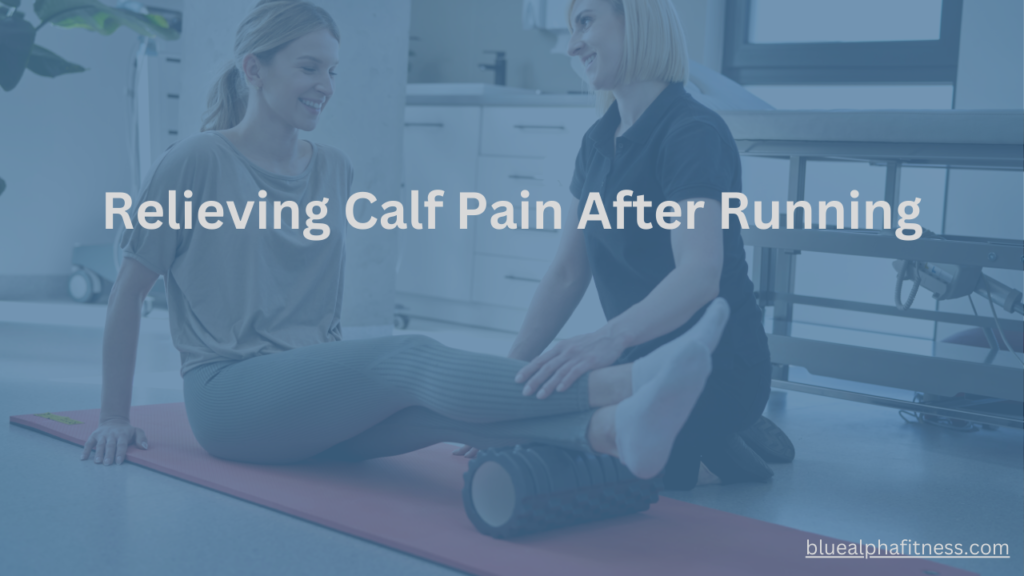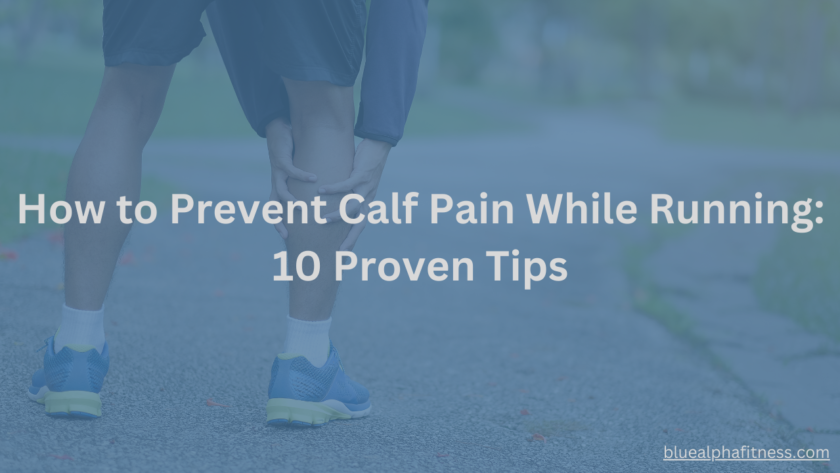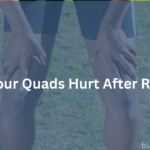Let’s be real: calf pain while running is the worst. You’re out there, feeling good, and suddenly—bam!—your calves are screaming.
It’s frustrating, right? You’re not alone.
That annoying, nagging pain can stop even the most determined runner in their tracks. But it doesn’t have to be this way.
So, how do you prevent calf pain while running? The answer is simple: it’s all about preparation. From warming up properly to wearing the right shoes, there are key things you can do to keep those calves happy and pain-free.
In this article, I’ll break down ten easy tips that’ll help you run without feeling like your legs are fighting against you.
Ready to say goodbye to that calf pain once and for all?
Let’s dive in.
What Causes Calf Pain While Running?
The causes of calf pain while running include tight muscles, fatigue, improper running form, footwear issues, dehydration, and pre-existing injuries.
Understanding the root of the problem is key to stopping it before it starts, helping you prevent discomfort and keep your runs pain-free.
1. Tight Muscles
One of the most common causes of calf pain is tight muscles.
When we run, the calves take a huge part of the workload, especially if we’re not stretching or warming up properly.
Imagine pulling a rubber band that’s too stiff—it snaps.
Your muscles, when not loosened up, can do the same. And trust me, that’s not a feeling you want.
Here’s the thing: we often don’t notice how tight our calves are until they start hurting.
That tension builds up over time, especially if you sit a lot during the day or aren’t regularly stretching.
Tight muscles are like ticking time bombs. The more rigid they get, the more likely you are to feel that painful twinge mid-run.
2. Overuse or Fatigue
Runners are often guilty of pushing their bodies beyond their limits.
If you’re clocking in too many miles without giving your calves a break, you’re bound to feel it.
Think of your muscles like rechargeable batteries. Every run drains them a little more, and if you’re not giving them time to recharge, they’re going to fail you when you least expect it.
Overuse happens when you increase your mileage too quickly or run too frequently without proper recovery.
It’s like trying to sprint a marathon—your muscles simply can’t keep up.
Fatigue builds, and suddenly your calves feel like they’re made of lead.
3. Improper Running Technique
Running is all about form.
When your technique is off, your body compensates in ways that can lead to injury.
Many runners land heavily on their heels or toes, placing extra strain on their calves.
It’s kind of like trying to drive with a flat tire—it doesn’t work smoothly, and something’s bound to go wrong.
For example, if you lean too far forward when running or don’t engage your core, your calves are forced to do more than they should.
Over time, this uneven workload can lead to pain that just won’t quit.
4. Footwear Issues
Worn-out shoes or the wrong type of footwear can be the sneaky culprit behind your calf pain.
Shoes are the foundation of your running form, and if they’re not supporting you properly, your calves will suffer the consequences.
If your shoes lack adequate cushioning or arch support, your feet and legs will work overtime to stabilize you.
It’s like trying to walk on sand—constantly shifting and never quite balanced.
Old shoes with flattened soles can also throw off your gait.
Without proper shock absorption, the impact travels up your legs, hitting your calves hard.
Your shoes might feel fine, but if they’ve clocked too many miles, it’s time to replace them.
5. Dehydration and Electrolyte Imbalance
Ever had a cramp stop you in your tracks? Often, dehydration and lack of electrolytes are to blame.
When your body’s low on fluids, muscles—especially in your calves—can start cramping up.
Water isn’t enough by itself; you also need electrolytes like sodium and potassium to keep your muscles firing properly.
Think of your muscles as a well-oiled machine. When they’re hydrated and balanced, they run smoothly. But take away the fluids, and everything seizes up.
Cramps are your body’s way of telling you it’s missing something important, and if you don’t replenish those electrolytes, the pain will just keep coming.
6. Pre-existing Injuries
Sometimes, calf pain isn’t just about the run itself—it’s the result of an underlying issue.
Pre-existing injuries like Achilles tendonitis or plantar fasciitis can flare up and cause calf pain.
These injuries force your calves to overcompensate, working harder than usual just to keep you moving.
It’s like a domino effect. One small injury can lead to a chain reaction, affecting different parts of your body.
If you’ve got a lingering injury, it’s worth considering that your calf pain might not be the main problem but rather a symptom of something else.
How to Prevent Calf Pain While Running: Proven Tips
To prevent calf pain while running, start by warming up, stretching, and choosing the right shoes.
These steps are just the beginning!
Let’s dive into 10 game-changing tips to prevent calf pain and make running feel effortless.
1. Warm Up Before Running
Let’s face it—skipping a warm-up is tempting, especially when you’re short on time.
But if you’re not warming up properly, you’re setting yourself up for calf pain.
A good warm-up loosens your muscles, gets blood flowing, and preps your body for the demands of running.
A simple five-minute warm-up can make all the difference.
Start with some light jogging, then move into dynamic stretches like leg swings and calf raises.
Think of it as priming the engine before hitting the gas. Without it, you’re asking your muscles to go from zero to 100 without warning.
2. Stretch Regularly
Stretching is one of the easiest ways to prevent calf pain, yet it’s often overlooked.
After a run, your calves are tight, and if you don’t stretch them out, that tightness can build into something worse.
Regular calf stretches keep the muscles flexible and reduce the risk of strain.
Try a simple wall stretch: stand facing a wall, place one foot back, and push against the wall with your hands. You should experience a deep stretch in your calf.
Hold for 20-30 seconds, then switch sides.
It’s a small habit that makes a big difference over time.
3. Strengthen Calf Muscles
Building strength in your calves doesn’t just prevent pain; it makes you a stronger runner overall.
When your calves are weak, they fatigue faster, which can lead to cramping and injury.
Stronger calves can handle the demands of running, especially on longer runs.
Calf raises are a great exercise to build muscle endurance.
Stand on the edge of a step, let your heels drop below the step, and then lift up onto your toes.
Do three sets of 15-20 reps, and you’ll start to notice your calves feeling stronger and more resilient during runs.
4. Wear Proper Footwear
Your shoes are your first line of defense against calf pain.
Proper running shoes should provide support, cushion, and stability.
If your shoes are worn out or don’t fit right, your calves will pay the price.
When choosing running shoes, focus on fit and support.
A good pair of shoes should feel snug but not tight, with enough cushioning to absorb impact.
Replace your shoes every 300-500 miles to ensure they’re still providing the support your calves need.
5. Adjust Your Running Form
If your form is off, your calves could be taking on more work than they should.
Small tweaks to your running form can make a big difference in how your calves feel.
For example, try to land midfoot rather than on your heels or toes. This helps distribute the impact more evenly throughout your legs.
Engaging your core while running also takes pressure off your calves.
Think of your body as a system—when one part isn’t pulling its weight, other parts have to compensate.
By correcting your form, you’re giving your calves a break from doing all the heavy lifting.
6. Gradually Increase Mileage
Going from couch to marathon isn’t a smart move for your calves.
Gradually increasing your mileage allows your muscles to adapt to the new workload without getting overwhelmed.
If you try to ramp up too quickly, your calves won’t have time to recover, and that’s when injuries happen.
Follow the 10% rule: increase your weekly mileage by no more than 10% at a time.
It’s a slow and steady approach, but it’s the safest way to build endurance without overloading your calves.
7. Stay Hydrated
Hydration isn’t just about avoiding thirst—it’s about keeping your muscles happy.
Dehydrated muscles are more prone to cramping, and your calves are particularly vulnerable during a run.
Drinking enough water before, during, and after your run helps maintain muscle function and prevents painful cramps.
But it’s not just about water. Electrolytes play a big role too.
Sports drinks or electrolyte tablets can replenish the sodium and potassium your body loses through sweat, keeping those calf cramps at bay.
8. Listen to Your Body
Your body has a way of letting you know when something’s wrong.
If you start feeling tightness or pain in your calves, don’t push through it.
Ignoring early warning signs can turn a minor issue into a full-blown injury.
Take rest days when needed and pay attention to what your body is telling you.
If your calves are sore after a run, give them time to recover.
Sometimes, the best way to prevent pain is to simply listen to your body’s signals.
9. Foam Roll and Massage
Foam rolling is like a mini-massage for your calves.
It helps release muscle tension, improve circulation, and speed up recovery after a run.
Using a foam roller on your calves can reduce tightness and prevent pain from creeping in later.
Start by placing the foam roller under your calf, then slowly roll up and down the muscle, pausing on any tight spots.
It might feel uncomfortable at first, but that’s just your muscles releasing tension.
Over time, foam rolling will become your secret weapon against calf pain.
10. Include Recovery Days
Running every day might seem like the fastest way to get better, but without recovery, you’re actually slowing your progress.
Recovery days allow your muscles—especially your calves—to repair and rebuild stronger. Without them, you risk overuse injuries and persistent pain.
Recovery doesn’t mean you have to be completely sedentary.
Light activities like walking, swimming, or cycling can keep you moving without putting stress on your calves.
Rest days are just as important as your run days, so don’t skip them!
How Do You Relieve Calf Pain After Running?
To relieve calf pain quickly, you can rest your legs and apply ice to reduce inflammation. Stretching and gentle massage can also ease tension and improve blood flow, helping you recover faster.

Here are some effective ways to manage calf pain when it strikes:
1. Rest and Elevation
First things first: give your calves a break.
Resting allows the muscles to recover and repair any minor damage.
Elevating your legs can also reduce swelling and improve circulation, speeding up the healing process.
Think of it as letting your body hit the reset button. The more you push through the pain, the worse it can get, so take time to rest.
2. Ice Therapy
Ice is your friend when dealing with calf pain, especially in the first 24-48 hours after the pain starts.
Applying ice to the affected area helps reduce inflammation and numb the pain.
Use an ice pack wrapped in a cloth and apply it to your calf for 15-20 minutes every couple of hours.
It’s a simple but effective way to calm angry muscles.
3. Stretching and Gentle Massage
Once the initial pain subsides, gentle stretching can help loosen tight muscles and prevent further stiffness.
Stretching relieves tension and promotes blood flow to the area, aiding recovery.
A seated calf stretch is a great place to start. Sit on the floor with your legs extended, wrap a towel around the ball of your foot, and gently pull the towel toward you, keeping your leg straight.
Massage also works wonders for tight calves.
Using your hands or a foam roller, gently massage the sore muscles to release tension and improve circulation.
Think of it like untangling a knot—slow and steady movements help work out the tightness.
4. Heat Therapy (After 48 Hours)
While ice is great for immediate pain, heat therapy is beneficial for relieving ongoing discomfort after the initial inflammation has gone down.
Applying heat to the affected area relaxes the muscles and increases blood flow, helping the healing process.
Use a heating pad or warm towel, applying it for 15-20 minutes at a time.
It’s a soothing way to ease muscle stiffness and prevent pain from lingering.
5. Over-the-Counter Pain Relief
For more severe or persistent pain, over-the-counter anti-inflammatory medications like ibuprofen can provide relief.
These medications reduce inflammation and pain, making it easier to manage discomfort.
Just remember to follow the dosage instructions and consult a doctor if the pain persists or worsens.
6. Compression
Wearing compression sleeves or socks can help reduce swelling and support the calf muscles.
Compression improves circulation, reduces muscle vibration, and can prevent further strain while your muscles heal.
This method is especially useful if you need to stay on your feet but want to minimize discomfort.
By combining rest, ice, gentle stretches, and heat therapy, you can relieve calf pain and speed up recovery.
If the pain persists, however, it may be time to seek medical attention.
When to See a Doctor for Calf Pain
If you’ve tried all the tips and still experience persistent calf pain, it’s time to consult a doctor.
Some issues, like muscle strains, tears, or more serious conditions like deep vein thrombosis (DVT), require medical attention.
While most calf pain can be treated with rest and recovery, ignoring chronic pain can lead to long-term problems.
Signs that you should see a doctor include swelling, bruising, or pain that doesn’t improve with rest.
If your calf pain is paired with redness or warmth in the area, it could be a sign of a blood clot, which is a medical emergency.
FAQs on How to Prevent Calf Pain While Running: Your Top FAQs Answered
Now, let’s address the commonly asked questions to further your knowledge on how you can prevent calf pain during and after running.
1. Is it okay to run through calf pain?
No, you should not run through calf pain. Running with pain can worsen the injury and lead to more serious problems.
2. How to fix tight calves when running?
To fix tight calves when running, you should stretch before and after your run. Calf stretches and foam rolling help loosen tight muscles.
3. How to avoid calf injury running?
You can avoid calf injury while running by warming up properly, strengthening your calf muscles, and gradually increasing your running intensity.
4. How can I get my calves to stop hurting?
You can get your calves to stop hurting by resting, applying ice, and stretching the muscles. If pain persists, seek medical advice.
5. How to get rid of calf cramps while running?
To get rid of calf cramps while running, you should stop running, stretch the affected muscle, and hydrate with electrolytes to prevent further cramping.
6. How to jog properly?
To jog properly, maintain good posture, land mid-foot, and keep a steady, relaxed pace. Proper form helps reduce strain on the calves.
7. How to make legs stronger for running?
To make your legs stronger for running, perform strength exercises like squats, lunges, and calf raises regularly.
8. When to worry about calf pain?
You should worry about calf pain if it persists despite rest, is accompanied by swelling, redness, or warmth, or worsens with time.
9. How long does calf pain last?
Calf pain typically lasts a few days to a week, depending on the severity of the strain. Rest and treatment speed up recovery.
10. What is the best exercise for calf pain?
The best exercise for calf pain is calf stretches, which improve flexibility and reduce tension in the muscles.
11. How to loosen calf muscles fast?
To loosen calf muscles fast, perform dynamic stretches and foam roll the tight areas. Heat therapy also helps relax the muscles.
12. How should I sleep to relieve calf pain?
You should sleep with your legs elevated to relieve calf pain. Elevation reduces swelling and promotes circulation.
13. What drink stops leg cramps?
Drinks with electrolytes, like sports drinks or water with added minerals, help stop leg cramps by replenishing lost electrolytes.
14. Why do I get sharp pains in my calves when I run?
Sharp pains in your calves when running can be due to muscle strain, dehydration, or overuse. Stretching and hydration are key to prevention.
The Final Word on How to Prevent Calf Pain While Running
If you’re here, you’re probably fed up with your calves screaming every time you run.
Maybe you’re thinking, “Why does this keep happening to me? I just want to run without pain!”
I get it. It’s frustrating to feel like your body’s holding you back when all you want is to enjoy your run.
But here’s the thing—you’re not stuck with this pain forever.
You’ve got the tools now. From stretching and strength exercises to proper hydration and pacing, you’ve learned how to prevent calf pain while running.
Sure, it might take some time, but with consistency, you’ll notice those tight calves relaxing, and your runs getting smoother.
This is your journey, and every step forward is progress. So don’t give up.
Soon enough, you’ll be running pain-free, stronger than ever.
You’ve got this! Keep going. The finish line’s in sight.



